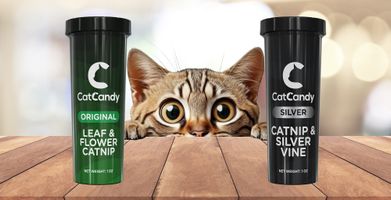Feline
Your go-to blog for all things cats! From understanding their quirky behaviors to tips on care, health, and fun, we’re here to help you celebrate and nurture your feline friends. Dive into a world of purrs, whiskers, and paws as we explore the unique joys of living with cats.

Understanding Catnip and Silvervine
Why They Drive Cats Crazy
Cats are known for their curious and sometimes unpredictable behavior, but nothing seems to excite them quite like catnip or silvervine. These plants have a magical effect on many cats, making them roll, rub, purr, and generally act a little wild. But what exactly are catnip and silvervine, and why do they have such a profound effect on our feline friends? Let's dive into the science and mystery behind these fascinating plants.
What is Catnip?
Catnip, or Nepeta cataria, is a perennial herb belonging to the mint family. It’s native to Europe and Asia but has become widespread across North America. The plant is characterized by its heart-shaped leaves, square stem, and clusters of tiny, lavender-colored flowers. While it may look like an ordinary garden herb, catnip has a special place in the hearts of cat owners and their pets.
The Science Behind Catnip
The secret behind catnip’s allure lies in a compound called nepetalactone. This chemical is found in the leaves, stems, and seeds of the catnip plant. When cats sniff catnip, nepetalactone binds to receptors in their nasal tissue, triggering a response in the brain. This response is similar to how certain chemicals in the brain react to pheromones.
The effects of catnip can vary among cats. Typically, cats may exhibit behaviors like rolling on the ground, rubbing their face against the plant, purring, drooling, and even becoming hyperactive. These effects usually last about 10 to 15 minutes, after which the cat becomes temporarily immune to the effects for about an hour.
Interestingly, not all cats are affected by catnip. Sensitivity to catnip is hereditary, and about 50-70% of cats have this sensitivity. Kittens and older cats are often less responsive to catnip, indicating that the sensitivity may develop with age.
What is Silvervine?
Silvervine (Actinidia polygama) is another plant that has a similar effect on cats, though it’s less known outside of Asia. Native to the mountainous regions of China and Japan, silvervine has been used in traditional medicine and as a cat stimulant for centuries.
The Active Compounds in Silvervine
Silvervine contains two active compounds: actinidine and dihydronepetalactone. These compounds work similarly to nepetalactone in catnip but are often more potent, meaning that even cats that do not react to catnip might respond to silvervine.
When exposed to silvervine, cats exhibit behaviors similar to those seen with catnip, including rolling, rubbing, and playful activity. Some studies suggest that up to 80% of cats respond to silvervine, making it a great alternative for cats indifferent to catnip.
Why Do Cats Go Crazy?
The exact reason why cats react so strongly to catnip and silvervine remains a mystery, though there are a few theories. One popular theory is that the active compounds in these plants mimic feline pheromones, specifically those related to mating. This could explain why the behaviors exhibited are often associated with affection and playfulness.
Another theory suggests that the compounds trigger a euphoric or hallucinogenic response in cats, similar to how certain drugs affect humans. This would explain the wide range of behaviors, from hyperactivity to extreme relaxation, observed in cats exposed to these plants.
Safety and Usage
Both catnip and silvervine are completely safe for cats. They are non-toxic and non-addictive, meaning your cat can enjoy them regularly without any adverse effects. However, it's best to use them in moderation to prevent overstimulation.
Catnip and silvervine can be offered in various forms, such as dried leaves, sprays, or even infused into toys. Each cat may have a preference for how they enjoy these plants, so it might take some experimentation to find out what your cat likes best.
Conclusion
Catnip and silvervine offer a fascinating glimpse into the sensory world of cats. While not all cats are affected by these plants, those that are can experience moments of pure joy and playfulness. Understanding the science behind these reactions not only deepens our bond with our feline companions but also adds a touch of wonder to the everyday interactions we share with them. So, the next time you give your cat a pinch of catnip or a sprinkle of silvervine, you'll know a bit more about the magic behind their playful antics.
